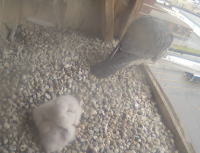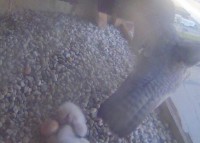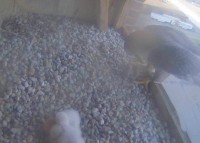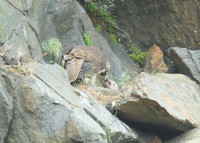Unhatched “addled” egg remains?
May 12, 2019 in In the Nest Box, lawrence peregrines
Today started off under light winds, overcast skies and temp at 47F. How nice to see the little ones starting to move around a bit more. They were first seen tightly huddled around each other and the remaining unhatched egg. It almost looked like they were trying to incubate the egg themselves!
 The female was observed around 9:20 AM this morning taking a break, moving to front edge of nestbox, and calling for food! The fourth egg has not hatched, and at this point, it is unlikely to hatch. In prior years, the falcons have had unhatched eggs. An unhatched egg, may also be referred at as an addled egg. This is an egg in which the developing embryo has died. Not to be confused with a clear or infertile egg, though in common usage the term is often applied to any egg gone bad.
The female was observed around 9:20 AM this morning taking a break, moving to front edge of nestbox, and calling for food! The fourth egg has not hatched, and at this point, it is unlikely to hatch. In prior years, the falcons have had unhatched eggs. An unhatched egg, may also be referred at as an addled egg. This is an egg in which the developing embryo has died. Not to be confused with a clear or infertile egg, though in common usage the term is often applied to any egg gone bad.
 Around 9:25AM, after a lot of vocalizing, the female was provided with another meal, by the male for the chicks. The photo shows the female returning to the huddled chicks, with prey in her bill. The bird in her bill has been stripped of feathers and is ready for her to rip apart for feeding purposes. Also visible is the remaining unhatched egg. Addled eggs are usually left, and may survive after the young have gone as dried and bleached relics, kicked to the side of the nest box, but they are often broken and trampled to pieces!
Around 9:25AM, after a lot of vocalizing, the female was provided with another meal, by the male for the chicks. The photo shows the female returning to the huddled chicks, with prey in her bill. The bird in her bill has been stripped of feathers and is ready for her to rip apart for feeding purposes. Also visible is the remaining unhatched egg. Addled eggs are usually left, and may survive after the young have gone as dried and bleached relics, kicked to the side of the nest box, but they are often broken and trampled to pieces!
Literature cited:
Ratcliffe, D. 1993. The Peregrine Falcon. 2nd ed. Carlton, England: T. and A. D. Poyser.



